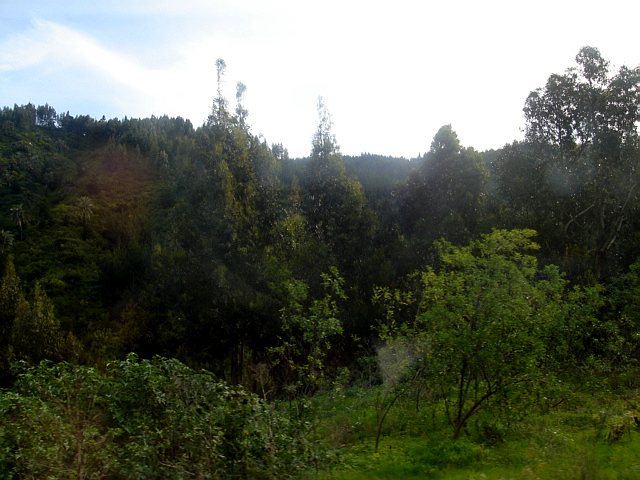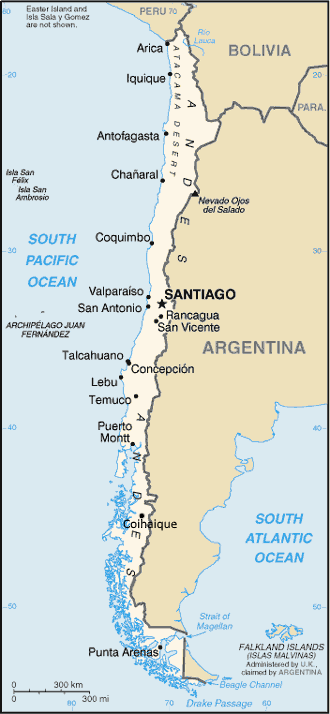|
Huechuraba
Huechuraba () is a city and commune of Chile located in Santiago Province, Santiago Metropolitan Region. Demographics According to the 2002 census of the National Statistics Institute, Huechuraba spans an area of and has 74,070 inhabitants (36,433 men and 37,637 women), and the commune is an entirely urban area. The population grew by 19.9% (12,286 persons) between the 1992 and 2002 censuses. The projected 2006 population was 82,200 (2006 projection) Statistics *Average annual household income: $52,904 ( PPP, 2006) *Population below poverty line: 14.5% (2006) *Regional quality of life index: 73.23, medium, 31 out of 52 (2005) *Human Development Index: 0.737, 56 out of 341 (2003) Administration As a commune, Huechuraba is a third-level administrative division of Chile administered by a municipal council, headed by an alcalde who is elected by popular vote every four years. The 2024-2028 alcalde is Maximiliano Luksic Lederer (Ind/ UDI) who was elected for the 2024-2028 term. T ... [...More Info...] [...Related Items...] OR: [Wikipedia] [Google] [Baidu] |
Santiago Metropolitan Region
Santiago Metropolitan Region () is one of Chile's 16 first-order administrative divisions. It is the country's only landlocked administrative region and contains the nation's capital, Santiago. Most commercial and administrative centers are located in the region, including Chile's main international airport, Arturo Merino Benítez International Airport. With an area of and population over seven million, it is Chile's most populated and most densely populated region. History The region's history of European influence started in 1542, a few days after Santiago was founded. When the Santiago cabildo was built, its function was to supervise the entire territory. Later, with the creation of the cities of La Serena and Concepción and the creation of their respective cabildos, its territorial reach was reduced. On 30 August 1826, 8 provinces were created, with the Santiago Province being one of them, but it wasn't until 1980 that the Metropolitan Region was created. Geography ... [...More Info...] [...Related Items...] OR: [Wikipedia] [Google] [Baidu] |
Administrative Division Of Chile
The administrative division or territorial organization of Chile exemplifies characteristics of a unitary state. State administration is functionally and geographically decentralized, as appropriate for each authority in accordance with the law. For the interior government and administration within the State, the territory of the republic has been divided into 16 regions (''regiones''), 56 provinces (''provincias'') and 346 communes (''comunas'') since the 1970s process of reform, made at the request of the National Commission on Administrative Reform (''Comisión Nacional de la Reforma Administrativa'' or CONARA). State agencies exist to promote the strengthening of its regionalization, equitable development and solidarity between regions, provinces and communes within the nation. Since 2005, the creation, abolition and designation of regions, provinces and communes, the altering of their boundaries, and the establishment of the regional and provincial capitals are part of ... [...More Info...] [...Related Items...] OR: [Wikipedia] [Google] [Baidu] |
Communes Of Chile
A commune (, ) is the smallest administrative subdivision in Chile. It may contain cities, towns, villages, hamlets as well as rural areas. In highly populated areas, such as Santiago, Valparaíso and Concepción, a conurbation may be broken into several communes. In sparsely populated areas, conversely, a commune may cover a substantial rural area together with several settled areas which could range from hamlets to towns or cities. The term "commune" is ambiguous in English, but the word is commonly used in translation for "comuna", although with some controversy among translators. A comuna is similar to a "county" in Anglo-American usage and practice, and may be more universally understood as a "municipality". Each commune or municipality is governed by a directly elected body known as a municipal council (''concejo municipal'') consisting of a mayor (''alcalde'') and a group of councillors (''concejales''), for a period of four years. The communal civil service admin ... [...More Info...] [...Related Items...] OR: [Wikipedia] [Google] [Baidu] |
Santiago Province, Chile
Santiago Province () is one of the six provinces of the Santiago Metropolitan Region (RM) of central Chile. It encompasses the majority of the population of that region, including 31 of the 36 communities of Greater Santiago. The province spans . Administration As a province, Santiago is a second-level administrative division of Chile. As its capital is also the regional capital, the duties of the provincial delegate are instead carried out by the regional delegate of the Santiago Metropolitan Region who is appointed by the president. Communes The province comprises 32 communes ( Spanish: ''comunas''), each governed by a municipality consisting of an alcalde and municipal council. Climate and natural features The climate of the Santiago Province, and generally of the Metropolitan Region is temperate Mediterranean cold, of the kind called ''continental''. Precipitation is concentrated in the winter months, generally as snow over 1000 m above sea level and, in colder years, o ... [...More Info...] [...Related Items...] OR: [Wikipedia] [Google] [Baidu] |
List Of Cities In Chile
This is a list of cities in Chile. A city is defined by Chile's National Statistics Institute (Chile), National Statistics Institute (INE) as an "urban entity"An "urban entity" is defined by Chile's National Statistics Institute (Chile), National Statistics Institute as a concentrated group of dwellings with over 2,000 inhabitants, or between 1,001 and 2,000 inhabitants if 50% or more of its population is economically active, dedicated to Secondary sector of the economy, secondary and/or Tertiary sector of the economy, tertiary activities. Exceptionally, populated centers dedicated to tourism and recreation with over 250 concentrated dwellings and that do not meet the population requirement are considered urban. with more than 5,000 inhabitants. This list is based on a June 2005 report by the INE based on the 2002 census which registered 239 cities across the country. Complete list of cities by region Largest urban agglomerations This list includes conurbations, "absorption ... [...More Info...] [...Related Items...] OR: [Wikipedia] [Google] [Baidu] |
Greater Santiago
Santiago (, ; ), also known as Santiago de Chile (), is the capital and largest city of Chile and one of the largest cities in the Americas. It is located in the country's central valley and is the center of the Santiago Metropolitan Region, which has a population of seven million, representing 40% of Chile's total population. Most of the city is situated between above sea level. Founded in 1541 by the Spanish conquistador Pedro de Valdivia, Santiago has served as the capital city of Chile since colonial times. The city features a downtown core characterized by 19th-century neoclassical architecture and winding side streets with a mix of Art Deco, Gothic Revival, and other styles. Santiago's cityscape is defined by several standalone hills and the fast-flowing Mapocho River, which is lined by parks such as Parque Bicentenario, Parque Forestal, and Parque de la Familia. The Andes Mountains are visible from most parts of the city and contribute to a smog problem, particula ... [...More Info...] [...Related Items...] OR: [Wikipedia] [Google] [Baidu] |
Regions Of Chile
Chile is divided into 16 regions (in Spanish language, Spanish, ''regiones''; singular ), which are the country's first-level administrative division. Each region is headed by directly elected Regional Governor (Chile), regional governor (''gobernador regional'') and a regional board (''consejo regional''). The regions are divided into Provinces of Chile, provinces (the second-level administrative division), each headed by a governor (''gobernador'') appointed by the President. There are 56 provinces in total. Provinces are divided into Communes of Chile, communes (the third and lowest level administrative division), which are governed by municipal councils. Naming Each region was given a Roman numeral, followed by a name (e.g. ''IV Región de Coquimbo'', read as "fourth region of Coquimbo" in Spanish). When the regional structure was created, Roman numerals were assigned in ascending order from north to south, with the northernmost region designated as I (first) and the southern ... [...More Info...] [...Related Items...] OR: [Wikipedia] [Google] [Baidu] |
Purchasing Power Parity
Purchasing power parity (PPP) is a measure of the price of specific goods in different countries and is used to compare the absolute purchasing power of the countries' currency, currencies. PPP is effectively the ratio of the price of a market basket at one location divided by the price of the basket of goods at a different location. The PPP inflation and exchange rate may differ from the Exchange rate, market exchange rate because of tariffs, and other transaction costs. The purchasing power parity indicator can be used to compare economies regarding their gross domestic product (GDP), labour productivity and actual individual consumption, and in some cases to analyse price convergence and to compare the cost of living between places. The calculation of the PPP, according to the OECD, is made through a ''basket of goods'' that contains a "final product list [that] covers around 3,000 consumer goods and services, 30 occupations in government, 200 types of equipment goods and about ... [...More Info...] [...Related Items...] OR: [Wikipedia] [Google] [Baidu] |
Liberal Party Of Chile (2013)
The Liberal Party of Chile () is a social-liberal political party in Chile, founded 26 January 2013 in Santiago, Chile. The main figure of the party is the deputy Vlado Mirosevic. Ideology The Liberal Party of Chile states itself to be a social-liberal party, promoting egalitarian liberalism and progressivism. Chilean social liberalism In Chile, the word liberal is, after the dictatorship of Augusto Pinochet, often synonymous with technocracy, classic liberalism and economic liberalism. The Liberal Party of Chile is based on social liberalism and thus opposes the neoliberalism that still influences many Chilean institutions. Following the tradition of the first liberals of the 19th century, the Liberal Party of Chile intends to combine its economic policy with a strong social policy. Platform The Liberal Party of Chile supports same-sex marriage, the legalisation of marijuana, the legalisation of abortion and the legalisation of euthanasia. Further, they support decentr ... [...More Info...] [...Related Items...] OR: [Wikipedia] [Google] [Baidu] |
Evópoli
Political Evolution (), also known in Spanish by its shorthand Evópoli, is a Chilean centre-right political party, founded in 2012. The party defines itself as a liberal platform for the people who look for a "modern centre-right who proposes as the central axis of their proposal the appreciation of diversity, the emphasis on encouraging local communities and the pursuit of social justice". History Felipe Kast, Luciano Cruz-Coke, Harald Beyer and Juan Sebastián Montes founded the movement on 12 December 2012. Evópoli agreed to participate in the primary parliamentary elections of National Renewal in 2013. Of the three candidates presented to the primaries, Eduardo Cuevas was the winner in the 19th district (Independencia and Recoleta). Evópoli participated in the parliamentary elections with five candidates for parliament, including Cuevas (district 19) and Felipe Kast (District 22). However, the senatorial candidacy of Luciano Cruz-Coke for the Antofagasta Region failed ... [...More Info...] [...Related Items...] OR: [Wikipedia] [Google] [Baidu] |
Communist Party Of Chile
The Communist Party of Chile (, ) is a communist party in Chile. It was founded in 1912 as the Socialist Workers' Party () and adopted its current name in 1922. The party established a youth wing, the Communist Youth of Chile (, JJ.CC), in 1932. History The PCCh was founded on 4 June 1912 by Luis Emilio Recabarren, after he left the Democrat Party. The party was initially known as the Socialist Workers' Party, before adopting its current name on 2 January 1922. It achieved congressional representation shortly thereafter and played a leading role in the development of the Chilean labor movement. Closely tied to the Soviet Union and the Third International, the PCCh participated in the Popular Front (''Frente Popular'') government of 1938, growing rapidly among the unionized working class in the 1940s. It then participated to the Popular Front's successor, the Democratic Alliance. Concern over the PCCh's success at building a strong electoral base, combined with the onset ... [...More Info...] [...Related Items...] OR: [Wikipedia] [Google] [Baidu] |



